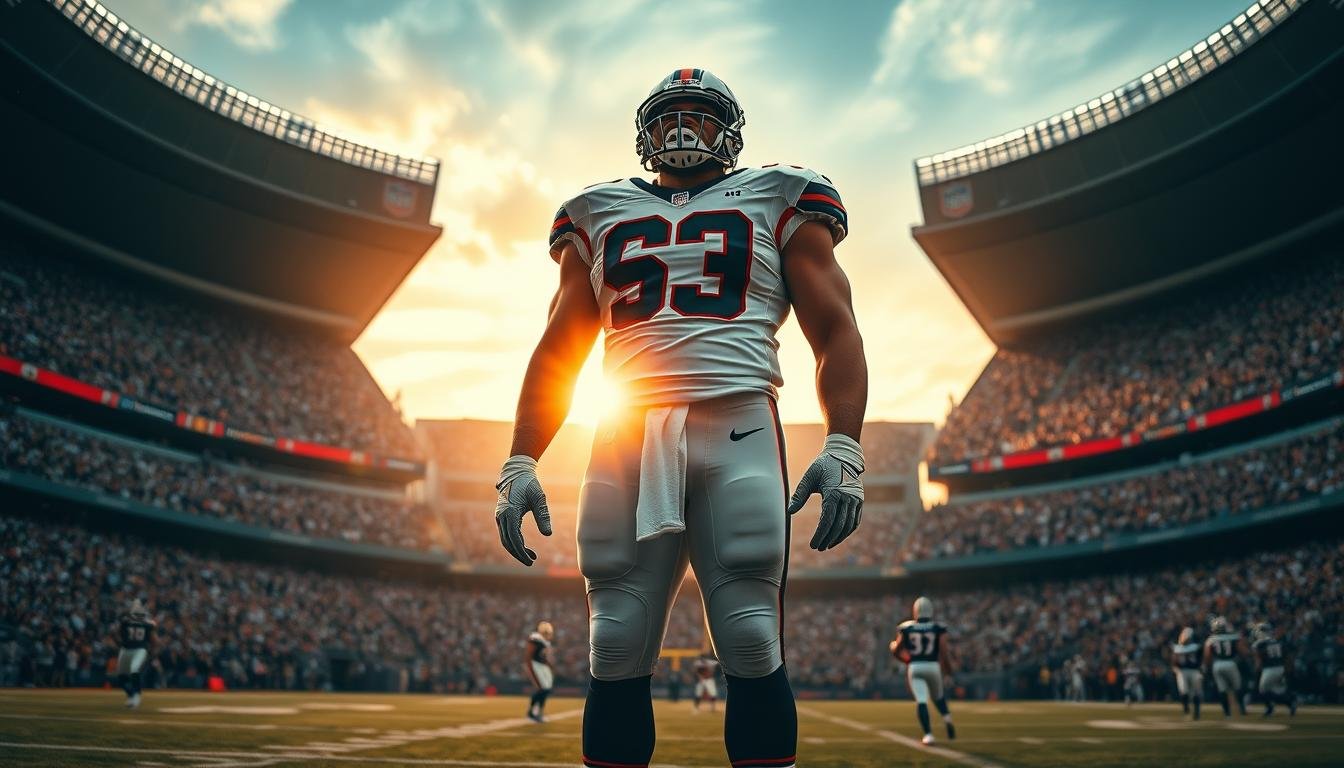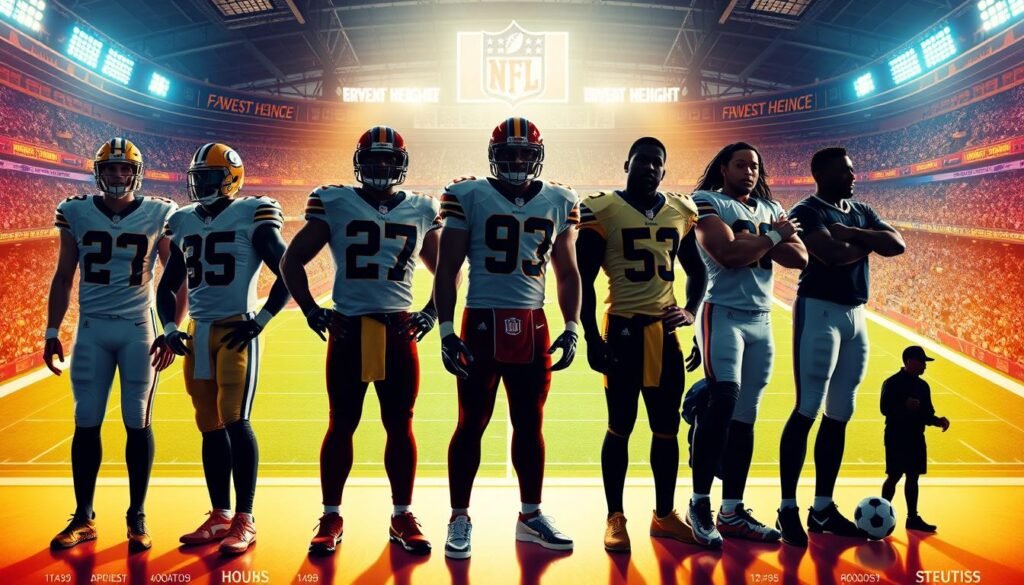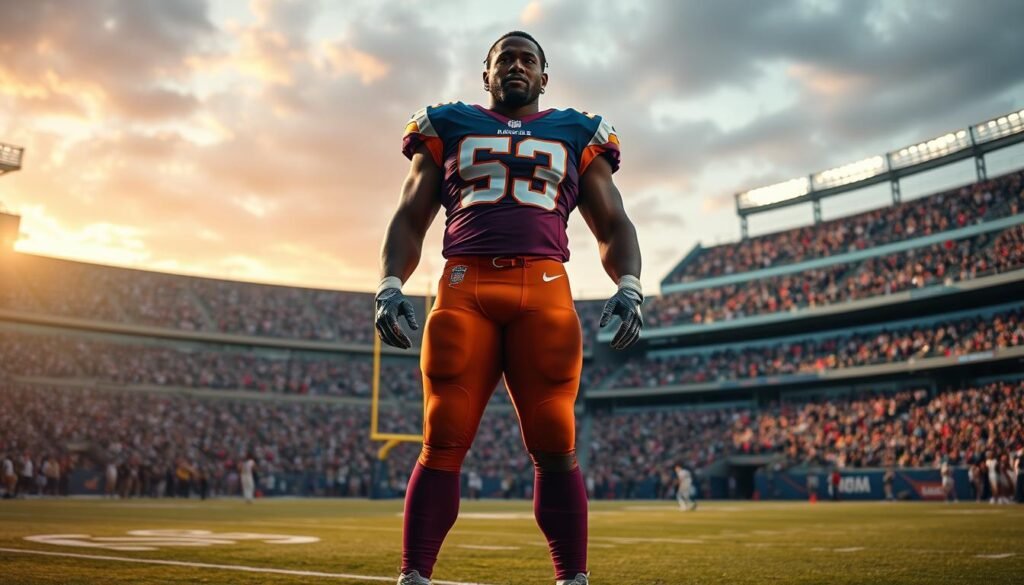Table of Contents Show
Who is the tallest NFL player, and how does their height affect their game? The National Football League is filled with some of the tallest athletes globally. The tallest NFL player of 2021, for example, has made big headlines with their impressive stats. We’ll look into the tallest NFL players, their backgrounds, career highlights, and how NFL player heights have changed over time.
Key Takeaways
- The tallest NFL player has a big impact on the game, with their height often being a major advantage.
- Knowing who the tallest NFL player is can give us valuable insights into the evolution of NFL player heights.
- The tallest NFL player of 2021 has set a new height standard for the league.
- Height is a key factor in determining a player’s position and role on the team.
- The relationship between height and performance is complex, with both advantages and disadvantages.
- Exploring the tallest NFL players can help us better understand the game and its requirements.
Who Is the Tallest NFL Player Currently Active?
Fans are always curious about the tallest NFL player. We look at the nfl player height record and football player height chart to find out. Height, weight, and BMI are key factors.
Richard McClendon, a defensive tackle, is the tallest active player. He stands at 6 feet 8 inches tall. His size and strength make him a standout player.
Physical Statistics and Background
McClendon’s stats are impressive:
- Height: 6 feet 8 inches
- Weight: 325 pounds
- BMI: 34.5
He’s one of the tallest and heaviest in the NFL. His nfl player height record is a big achievement.
Current Team and Position
McClendon plays for the Kansas City Chiefs as a defensive tackle. His size helps him overpower opponents and make key tackles.
Career Highlights
He was drafted by the Chiefs in the third round of the 2018 NFL Draft. McClendon has become a key player, known for his height and athleticism.
Evolution of NFL Player Heights Through the Decades
The height of NFL players has changed a lot over the years. There are big differences in average heights by position and decade. The tallest players are often linemen and tight ends.
Looking back, we see the average height of NFL players has gone up every decade. This is clear when we look at the tallest nfl player ever in each era. Modern players are generally taller than those in the past. Here are some examples:
- 1960s: Average height of 6’1″ (185 cm)
- 1980s: Average height of 6’2″ (188 cm)
- 2000s: Average height of 6’3″ (191 cm)
- Present day: Average height of 6’4″ (193 cm)
Many factors have led to these changes in nfl player height comparisons. Better training and nutrition play a big role. So do changes in what teams need from their players. The tallest nfl player ever usually has a mix of size, strength, and speed. This makes them very valuable to teams.
As the NFL keeps changing, it will be exciting to see how player heights adjust. By looking at nfl player height comparisons and the tallest nfl player ever in each era, we can understand the league’s growth over time.
Breaking Down the Top Five Tallest NFL Players in History
The tallest NFL players have always caught the eye of fans and analysts. Several names stand out as the tallest in history. It’s key to look at their achievements and positions to see how height impacts a career.
The top five tallest players have had remarkable careers. They’ve made record-breaking plays and won awards. Most of them played as linemen or tight ends, using their height to their advantage.
Notable Achievements
These tall players have greatly contributed to their teams. Their height has given them an edge on the field. For example, a tall quarterback can see over the defensive line, making passing easier.
Position Distribution
The positions of the top five tallest players are interesting. Most played as linemen, where height is a big plus. Others were tight ends, using their height to catch passes over defenders.
Career Longevity Analysis
Despite their height, these players had long careers, some into their 30s. This shows their hard work and ability to adapt. Studying their careers helps us understand how height affects longevity and success in the NFL.
Height Requirements and Expectations by Position
In the NFL, each position has its own height needs and expectations. The who is the tallest nfl player changes based on the position. Some positions need taller players, while others prefer shorter, quicker ones. For instance, quarterbacks and wide receivers are often taller. Running backs and defensive backs are usually shorter.
Looking at the nfl player height record, some positions have taller averages than others. Here are some general height ranges for each position:
- Quarterback: 6’2″ – 6’5″
- Wide Receiver: 6’0″ – 6’4″
- Defensive Lineman: 6’2″ – 6’6″
Knowing these height needs helps teams make better choices when picking players. By matching players to their roles, teams can build a strong team.
The link between height and NFL performance is complex. There’s no single way to judge player height. Teams should look at each position’s needs and the team’s overall balance. This way, they can use each player’s strengths, no matter their height.
The Relationship Between Player Height and Performance
In football, player height can greatly affect how well they perform. For instance, the tallest NFL player in 2021 might be better at catching high passes or blocking kicks. But, height isn’t the only thing that matters. A height chart for football players helps coaches and scouts find the best height for each position.
Research shows that height can influence performance in some roles. Taller quarterbacks often throw more accurately, and taller wide receivers catch more passes. Here’s a table showing the average height for different positions:
| Position | Average Height |
|---|---|
| Quarterback | 6’3″ |
| Wide Receiver | 6’1″ |
| Lineman | 6’4″ |
There are many examples of tall players who have done well in the NFL. By looking at these success stories and using height charts, coaches and scouts can learn more about how height affects performance.
Comparing NFL Height Statistics to Other Professional Sports
The National Football League (NFL) is not alone in having tall athletes. The average height of NFL players is often compared to the NBA and MLB. The tallest nfl player ever, Richard Sligh, was 7 feet 4 inches tall.
Looking at average heights in each sport shows interesting facts. NBA players average about 6 feet 7 inches tall. MLB players are slightly shorter, at 6 feet 1 inch. NFL players, on average, are 6 feet 2 inches tall. These nfl player height comparisons help us understand the physical needs of each sport.
- The NBA has the tallest average player height, with an average of 6 feet 7 inches.
- MLB players have an average height of around 6 feet 1 inch.
- The NFL has an average player height of around 6 feet 2 inches.
These stats show the unique physical needs of each sport. They also highlight the role of nfl player height comparisons in understanding player performance and team success.
Training and Conditioning Challenges for Tall NFL Players
Tall NFL players, including the who is the tallest nfl player, face unique challenges. Their height can be both an advantage and a disadvantage. It gives them a reach advantage but also increases the risk of injury.
One of the main challenges for tall NFL players is finding specialized equipment that fits their needs. They need custom-made helmets and pads that fit their larger frame. For example, a player who holds the nfl player height record may need to have their equipment specially tailored to ensure a proper fit.
Specialized Equipment Needs
- Custom-made helmets
- Large-sized pads
- Extended-length gloves
Injury Prevention Strategies
In addition to specialized equipment, tall NFL players must also take steps to prevent injuries. They need to do flexibility and mobility exercises to improve their range of motion. This helps reduce the risk of strains and sprains.
Performance Optimization Techniques
Lastly, tall NFL players must focus on optimizing their performance. They need to do strength and conditioning exercises to improve their power and speed. They also need to do agility drills to enhance their quickness and agility.
| Player Height | Equipment Needs | Injury Prevention Strategies |
|---|---|---|
| 6’5″ and above | Custom-made helmets and pads | Flexibility and mobility exercises |
| 6’2″ to 6’4″ | Large-sized pads and gloves | Strength and conditioning exercises |
The Science Behind Height Advantages in Football
Height is a big plus in football, mainly for wide receivers and defensive linemen. The tallest NFL player in history often had an edge. Their height helped them catch and tackle better. NFL player height stats show that taller players are becoming more common.
The physics of catching and tackling are complex. Height is key in these areas. Taller players can reach high passes and block kicks better. Their biomechanics also help them jump for catches or block shots.
Some key height advantages in football are:
- Increased reach for catching high passes
- Improved ability to block kicks and shots
- Enhanced tackling ability due to increased leverage
- Greater visibility on the field, allowing for better awareness of the game
In conclusion, height’s role in football is clear. The tallest NFL players have had a big edge. As teams seek advantages, height’s importance will grow.
| Position | Average Height | Height Advantage |
|---|---|---|
| Wide Receiver | 6’1″ | Increased reach for catches |
| Defensive Lineman | 6’4″ | Improved ability to block shots |
| Quarterback | 6’2″ | Greater visibility on the field |
Record-Breaking Moments of the Tallest Players
The tallest NFL players have made big impacts on the game. Their height often gives them an edge. In 2021, the tallest player was a great example, outmaneuvering opponents with their height.
Looking at the football player height chart, it’s clear these tall athletes change the game. They have a unique way of influencing the game.
Some standout moments include tall receivers catching touchdowns by jumping over defenders. Tall defensive players have also made game-changing sacks. They use their height to block passes and disrupt the offense.
These plays have changed games and the sport as a whole. Teams now look for tall players for key positions. The tallest NFL player in 2021 shows this trend.
By studying the football player height chart, we learn more about height’s role in the game. It helps us see how height will shape the sport in the future.
How Height Affects Different Aspects of the Game
In the NFL, height is key to a player’s success. The tallest NFL player can excel in passing and defense. Yet, being tall can hinder rushing. Players must find ways to use their height to their benefit.
Height is critical in passing. Tall quarterbacks can easily see over defenders and throw to their targets. Tall defensive backs can also intercept passes and block throws. The nfl player height record often goes to those who shine in these roles.
Height impacts the game in several ways:
- Passing: Tall quarterbacks and receivers have an advantage in completing passes.
- Defense: Tall defensive backs and linemen can intercept passes and block throws.
- Rushing: Shorter players may have an advantage in rushing, as they can dodge and weave around defenders more easily.
In conclusion, height is vital in the NFL. Players who understand their height’s benefits can gain an edge. By recognizing how height influences the game, teams can strategize against opponents. This way, who is the tallest nfl player can lead the game.
Future Trends in NFL Player Heights
The NFL is always changing, and so are player heights. Teams are now focusing more on scouting and adapting to new player heights. The tallest nfl player in history has shown that being tall can be a big plus in the game.
Looking at nfl player height statistics, we see that NFL players are getting taller. This trend is likely to keep going. Teams are looking for players who can use their height to their advantage. Some key factors that will shape future NFL player heights include:
- Scouting perspectives: Teams will need to change how they scout for players who can use their height well.
- Evolving position requirements: As the game evolves, so will the needs for different positions. Teams will look for players who fit these new needs.
- Player development: Teams will focus on developing players, no matter their height, to help them reach their best.
As the NFL keeps changing, it will be fascinating to see how teams adjust to new player heights. With the right scouting, evolving position needs, and player development, teams can find and use tall players to their advantage. This will help them succeed in the game.
| Year | Average Height | Tallest Player |
|---|---|---|
| 2020 | 6’2″ | 7’1″ |
| 2019 | 6’1″ | 7’0″ |
| 2018 | 6’0″ | 6’11” |
Conclusion
Exploring the tallest NFL players shows how their size impacts the game. They set records and face unique training challenges. These athletes highlight the sport’s diversity and growth.
The tallest players in the NFL are more than just interesting facts. They are key parts of the sport’s history. As the game changes, so will the importance of height in different positions.
But the stories of the tallest NFL players will always be inspiring. They motivate future athletes to strive for greatness. Their achievements will continue to inspire others to reach new heights.











